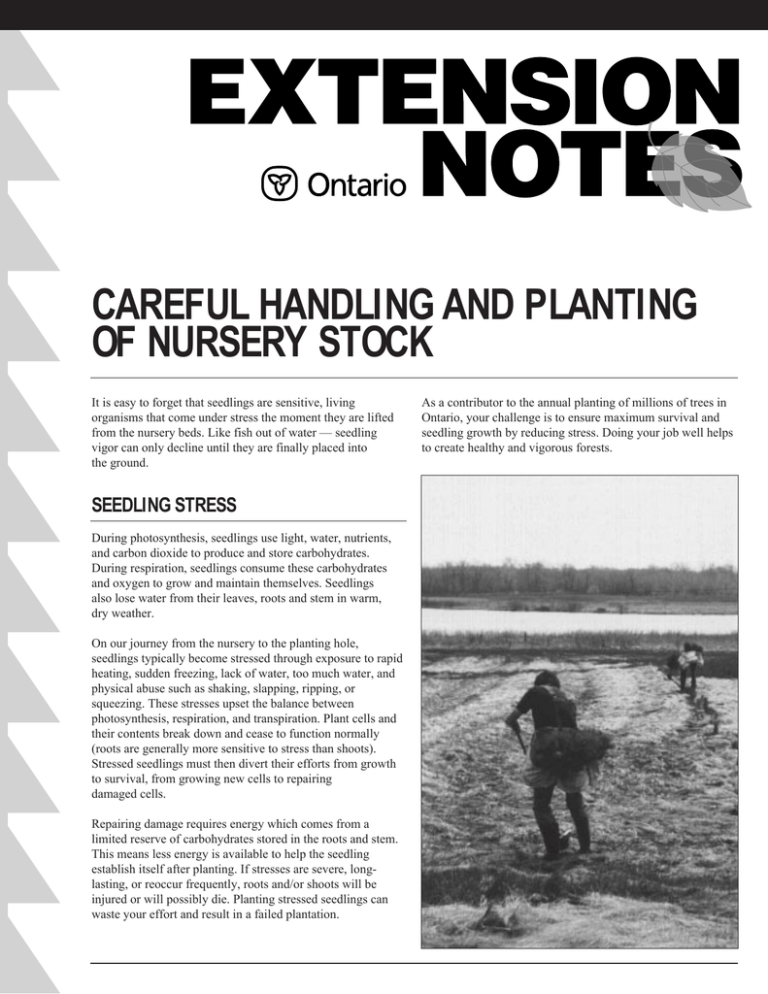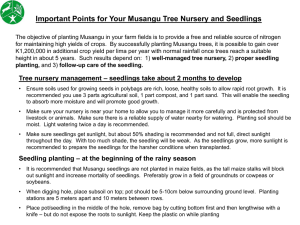CAREFUL HANDLING AND PLANTING OF NURSERY STOCK
advertisement

CAREFUL HANDLING AND PLANTING OF NURSERY STOCK It is easy to forget that seedlings are sensitive, living organisms that come under stress the moment they are lifted from the nursery beds. Like fish out of water — seedling vigor can only decline until they are finally placed into the ground. SEEDLING STRESS During photosynthesis, seedlings use light, water, nutrients, and carbon dioxide to produce and store carbohydrates. During respiration, seedlings consume these carbohydrates and oxygen to grow and maintain themselves. Seedlings also lose water from their leaves, roots and stem in warm, dry weather. On our journey from the nursery to the planting hole, seedlings typically become stressed through exposure to rapid heating, sudden freezing, lack of water, too much water, and physical abuse such as shaking, slapping, ripping, or squeezing. These stresses upset the balance between photosynthesis, respiration, and transpiration. Plant cells and their contents break down and cease to function normally (roots are generally more sensitive to stress than shoots). Stressed seedlings must then divert their efforts from growth to survival, from growing new cells to repairing damaged cells. Repairing damage requires energy which comes from a limited reserve of carbohydrates stored in the roots and stem. This means less energy is available to help the seedling establish itself after planting. If stresses are severe, longlasting, or reoccur frequently, roots and/or shoots will be injured or will possibly die. Planting stressed seedlings can waste your effort and result in a failed plantation. As a contributor to the annual planting of millions of trees in Ontario, your challenge is to ensure maximum survival and seedling growth by reducing stress. Doing your job well helps to create healthy and vigorous forests. Don’t assume that if a seedling looks healthy it is healthy. Can you tell just by looking at people whether they are in good health. As with people, by the time the symptoms are visible it is often too late. Stresses are also cumulative. Each stress adds to all the previous stresses from which the seedling may not have yet recovered. Remember — it is the cumulative effects of poor handling that jeopardize the survival and growth of the plantation. Carelessness may be the straw that breaks the seedling’s back. • • • • If using an open vehicle, provide shelter by covering with a reflective tarp, keeping the white side up. If placing in a car trunk, minimize travel time. Trunks heat very quickly and don’t provide adequate air circulation Do not transport fuel or chemicals with the trees On rough roads, drive as if the seedlings are boxes of eggs, not bales of hay Park in the shade ON PROPERTY OR SITE STORAGE Seedlings stored temporarily at your property must be provided with shade, cool temperatures, adequate irrigation water (not stagnant), protection from drying winds, and good ventilation. Avoid direct sunlight, standing water, and lowlying frost pockets. Plan ahead to choose the best storage spot. When choosing a location for storage, consider the following; • Conifer stands • North slopes (shady areas) • Under patches of snow • Close to fast-flowing streams • • • • • • If these locations are not present, you must create the proper storage conditions on your site. • Ensure the storage site is in the shade all day • Unload new seedlings immediately from the truck • Water as needed • Plant stored seedlings before picking up more • Handle gently — no tossing, dropping, or forcing into small spaces Storage temperatures should be one to five degrees Centigrade. Higher temperatures will stress trees. Plant bare-root stock the same day if the outside air temperature is over 15 degrees Centigrade; otherwise plant no later than the following day Do not stack bags Leave space around each bag for ventilation when storing or thawing Pack container trays together to minimize drying of edges and elevate trays slightly (five centimetres) to allow drainage Provide shelter by suspending a reflective tarp about one metre above uppermost seedlings, keeping the white side up and silver side down Shade, cool temperatures, and protection from drying winds are essential for seedling health during transportation to the planting site. CAREFUL HANDLING AND PLANTING OF NURSERY STOCK • • Ensure on-site storage time is absolutely minimal Prevent the plugs from drying out. If free water cannot be easily squeezed out of the plug, then it is too dry. Water the containers in the early morning with stream (not pond) • water until the plugs are saturated Be sure the trays are slightly elevated so that they do not sit in puddles of water LOADING PLANTING PAILS (BAGS) AND CARRYING SEEDLINGS The seedlings you receive should be in good condition. Your challenge is to add as little new stress as possible because stressed seedlings are more likely to stagnate and die after planting. • You can keep further seedling stress to a minimum by observing the following rules: • Do not open storage bags until ready to plant • Reseal partially used storage bags as quickly as possible • Do not use planting bags with rips or holes that would allow air in to dry roots • Dip roots in well oxygenated (not stagnant) cool, stream water up to one minute before planting if necessary • Put five centimetres of fresh, cool water or a saturated sponge moss in the bottom of the planting pail. Change the water as you add a new group of seedlings • • • • • • • Cut the bundling elastics; don’t rip them off. Separate the bundles or container plugs carefully, without stripping roots or loosening plugs Tightly close the storage bags or boxes each time you remove trees Load planting pails in the shade and out of the wind Place seedlings quickly into the planting pail Do not prune roots, especially if you see new white root tips Place seedlings in an upright position and pack loosely so that removal will not damage the tender roots If using a bag, collapse the top to keep in the moisture Before stopping for a break, empty the planting pail. If you must stop with trees left in the container place it in the shade PLANTING The future of the forest is in your hands. • Choose the best site, do not plant seedlings where there are water-holes, stumps or rocks and do not plant more than one tree per hole • Make sure the hole is deep enough for the root system • Carefully remove only one tree at a time (separate roots by shaking loose in the bag) and plant immediately • Lay the roots straight down in the hole in a natural arrangement — do not bunch, twist, double-over, or bend them • Keep organic matter, stones, and twigs out of the hole (unless the soil itself is organic). They create air pockets that dry out roots • Plant seedlings slightly above the root collar swelling. • Tamp soil with the toe (not the heel) to remove air pockets • For container stock, handle seedlings by the plug (not the stem) • Plant upright and cover the plug with soil. Do not bury live branches or foliage, or leave any roots exposed to the air • Take pride in a job well done Your time and effort in advance planning and preparation will result in a successful tree planting project. CAREFUL HANDLING AND PLANTING OF NURSERY STOCK 1 2 3 4 5 6 For more information contact: LandOwner Resource Centre P.O. Box 599, 5524 Dickinson Street Manotick, Ontario K4M 1A5 Tel 613 692 2390 or 1 800 387 5304 Fax 613 692 2806 Product Ordering: 1 888 571 INFO (4636) E-mail: info@lrconline.com Internet: http://www.lrconline.com Produced by: • LandOwner Resource Centre HOW TO PLANT Figures 1-3 : Prepare a planting hole by removing a “wedge” of soil. Dig one side of hole straight down. Figures 4-6 (: Place roots in the planting hole. Spread soil around the roots ensuring good contact. Tamp the soil around the base of the seedling with your toe. Your time and effort in advance planning and preparation will give your tree planting project the best chance for success. Your reward will be a lifetime of enjoyment and benefit from your trees. Practical advice and assistance on tree planting, site preparation and tending is available through your local office of the Ontario Ministry of Natural Resources. With support from: © 2000, Queen’s Printer for Ontario ISSN 1198-3744 R.P. (2k P.R., 00 11 29) • Ontario Ministry of Natural Resources Order Number: LRC 14 Cette publication est également disponible en français. ® printed on recycled paper



